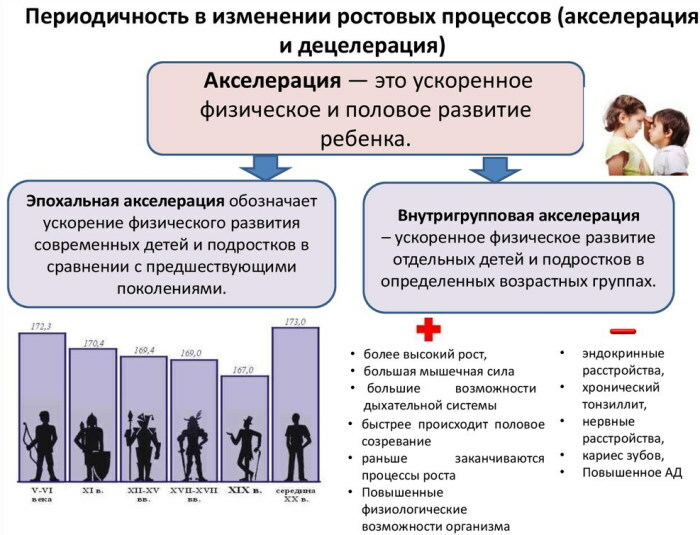Content
- What is a cotton-gauze headband for and when is it used?
- Material requirements
- Dimensions and standards
- For children
- For adults
- Step-by-step manufacturing instructions
- Bandage
- From the gauze cut
- From fabric
- On an elastic band
- What is the treatment of cotton-gauze dressings
- How to wear correctly
- Can the bandage be washed?
- Common mistakes when using cotton and gauze dressings
- Video about cotton-gauze bandage
Make a cotton-gauze bandage you can do it yourself. To do this, you should know what materials and tools may be required, as well as read several step-by-step master classes on making different types of dressings.
What is a cotton-gauze headband for and when is it used?
Cotton and gauze dressings are designed to protect the mucous membranes of the respiratory tract. They are put on the head, covering the mouth and nose. Long strings are tied at the back of the head or at the top of the head to keep the bandage from falling off.
A cotton gauze bandage is used in emergency situations when the air is contaminated with dust, smog and smoke, or chemical vapors such as chlorine or ammonia.
The product prevents the penetration of small particles into the body, which settle on the surface of the gauze and remain between the cotton layers.
This method of protecting the respiratory tract is short-term. It can be used when evacuating from a room with polluted air. Wearing the bandage for a long time in hazardous conditions is ineffective. Gradually, the product becomes saturated with harmful substances and begins to pass them through layers of cotton wool and gauze.
The dressings have another purpose: to protect the respiratory tract from the ingress of bacteria that provoke various diseases.
What diseases can the dressing protect against?
- diphtheria;

- whooping cough;
- scarlet fever;
- ODS.
There is an opinion that gauze and cotton bandages can prevent infection with influenza and coronavirus. Not all medical professionals agree with this statement. Viruses are much smaller than bacteria, therefore they are able to penetrate through multiple layers of the "mask". However, doctors do not recommend neglecting this method of protection during periods of epidemics.
The bandage should be worn in public places. It will help reduce the risk of getting sick and spreading the disease. Most of the particles that are transmitted from person to person by airborne droplets will settle on the layers of the "mask", and not directly enter the respiratory tract.
Bandages should be used for both sick and healthy people. After sneezing and coughing, there will be much less bacteria in the air around the patient. A healthy person, putting on a bandage, increases the level of protection of his body against infection by 35%. Disposable and reusable dressings can be used.
Material requirements
The dressing consists of 3 parts:
| Parts of the bandage | What to make |
| The foundation | A material that is breathable, such as fine cloth, gauze, or bandages. |
| Filter | It is laid between the layers of the base. Vata works best. |
| Strings | They are made from gauze, bandage or elastic tape. |
To ensure reliable respiratory protection, you need to make sure of the quality of the materials from which it will be made.
The density of the base material must be at least 35 g / m2. You can check the density at home by cutting off a piece 90x5 cm wide from fabric or gauze. The cut must be crumpled and weighed on a kitchen scale. The mass of the material of the required density will be about 162 g. Permissible error: 2 g.
To make the filter, you need cotton wool, without synthetic fibers. It should be free of debris and particulate matter. You can check the material for the presence of synthetics in the composition using an ultraviolet lamp. Natural fibers should not glow.
It is also important to make sure that the cotton wool is made up of long fibers. Small, dusty particles will enter the respiratory system, causing itching, irritation and other discomfort. The material needs to be fluffed, slightly shaken. If a cloud of fine dust forms around, then such cotton wool cannot be used to create a filter.
Doctors recommend using only sterile dressing materials.
Dimensions and standards
A cotton and gauze bandage will reliably protect the respiratory system if it is made of high-quality materials, and will also fit the size of the person who will wear it. Size standards differ for adults, children and teenagers.
For children
For children aged 3 to 6 years, the size of the cloth covering the face is 8x12 cm. Before you sew the product, you need to try it on. The child should feel comfortable. The length of the strings depends on their type, as well as on the girth of the head. Therefore, in the process of making the bandage, a measuring tape should be at hand.
The dimensions of the cloth covering the airways for children from 7 to 12 years old: 10x15 cm. For teenagers from 13 to 16 years old, a bandage of 14x14 cm is suitable. The product should fit snugly to the lower part of the face, therefore it is necessary to try on the bandage so that at the stage of stitching it would be possible to correct its size.
For adults
Standard size for adult headbands:
- The canvas covering the airways - 19x19 cm.
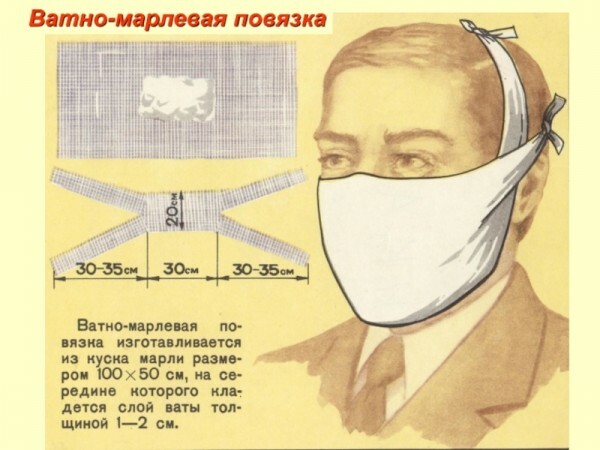
- Ties for fixing the bandage - 35 cm. If the ties are made of elastic, then the degree of elasticity must be taken into account. Ends that are too long will not be able to securely fix the product on the face.
- The full length of the bandage is 90 cm.
It is necessary to take into account the individual characteristics of a person. For example, men's and women's headbands can be of different sizes. For people with a full face, it is recommended to lengthen the ties and increase the size of the cloth covering the face by 5-7 cm.
The formula for calculating the size of the dressing:
The size of the cloth covering the face is equal to the distance between the ears in front, + 2 cm for fastening the strings.
The length of the bandages is equal to the circumference of the head divided by 2.
Step-by-step manufacturing instructions
A cotton-gauze bandage (you can make several types of bandages with your own hands), to protect the respiratory tract, it should be made of sterile materials. Before starting work, you need to wash your hands and make sure the table surface is clean.
Tools required for work:
- scissors;
- tape measure;
- sewing needle;
- sewing thread in white.
Further in the article, you can consider step-by-step instructions for making different types of dressings at home.
Bandage
A cotton-gauze bandage (you can make it yourself in 10 minutes) is made from a wide sterile bandage.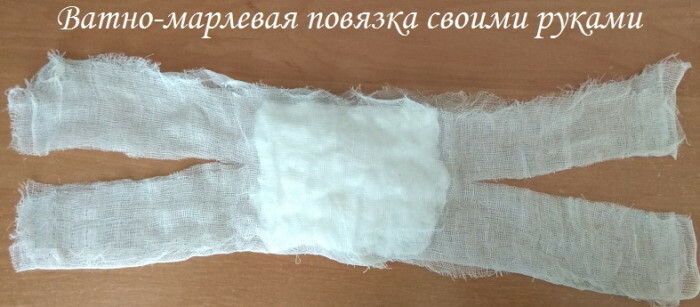
Instructions:
- Cut a rectangle 60x90 cm from the bandage.
- Spread it out on the table. Straighten it so that there are no wrinkles and folds.
- Break the cotton wool, flatten it on the table into a square with sides of 15 cm.
- Place in the center of the bandage.
- Fold the upper edge of the bandage towards the center of the bandage, covering part of the cotton wool.
- By analogy, bend the bottom of the bandage.
- Sew the edges of the bandage so that the cotton does not fall out.
- Spread out the sides of the bandage.
- Cut each side piece into 2.
- Sew the ties carefully so that the bandage does not fall off.
Putting on a bandage, the upper strings are fixed with a knot at the back of the head, and the lower ones - at the crown.
From the gauze cut
A cotton-gauze bandage (you can make such a bandage with your own hands in 10 minutes) is made of sterile wide gauze.
Instructions:
- Cut 2 rectangles from gauze 50x50 cm in size.
- Fold the blanks in half.
- Put them on top of each other.
- Fold 3 sides and sew them. You can use a sewing machine.
- Fluff cotton wool, flatten.
- Insert a cotton filter into the resulting pocket.
- Sew up the top of the "pocket".
- Cut 2 strips of gauze 35 cm long and 3.5 cm wide.
- Bend the edges of the strips towards the center.
- Fold each strip in half lengthwise.
- Sew the edges of the gauze to keep them from unraveling.
- Sew strings around the edges of the airway protection fabric. The tips should be on the inside.
Putting on a bandage, the strings are passed over the ears and fixed with a knot at the back of the head.
From fabric
The bandage can be made not only from gauze or cotton wool. You can use a cloth. The main thing is that it is not too dense. A person should breathe freely with a bandage on his face, without discomfort. The thickness of the cloth bandage together with the filter should not exceed 1.5 cm.
For the manufacture of the base, cotton or linen fabric is suitable. You can use chintz. These materials are thin and light, breathable well.

Instructions:
- Cut 2 rectangles 55x55 cm from the fabric.
- Fold rectangles in half.
- Fluff up the cotton wool and flatten it.
- Place the "filter" over the fabric.
- Put another blank on top of the cotton wool.
- Bend all sides and sew them, grabbing cotton wool.
- Cut 2 strips of fabric 35 cm long and 3.5 cm wide.
- Bend the edges of the strips towards the center.
- Fold each tape in half lengthwise.
- Sew the edges of the fabric to keep them from unraveling.
- Sew the strings on the edges of the airway protection fabric, placing the ends of the strings on the wrong side. The ties will be held in a knot at the back of the head.
This is a version of a reusable dressing that can be washed and reused.
On an elastic band
A cotton-gauze bandage (you can do 2 options for a bandage with an elastic band with your own hands) with elastic ties is convenient to use. You can make a mask with 1 tie, or you can sew a product similar to medical disposable dressings with 2 thin, elastic loops that cling to the ears.
Sewing instructions for 1 strap headband:
- Cut 2 rectangles 55x55 cm from fabric or gauze.
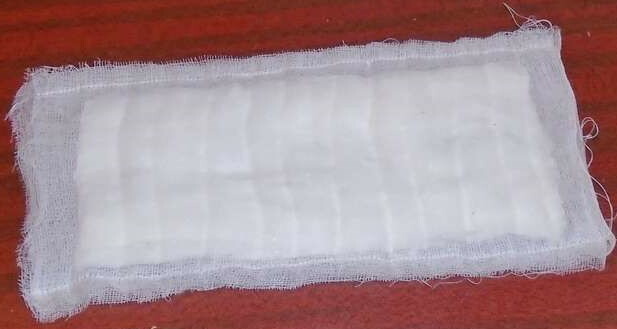
- Fold these blanks in half.
- Shred cotton wool, form a flat square.
- Place another piece of gauze or fabric on top of the cotton wool.

- Bend all sides and sew them, grabbing cotton wool.
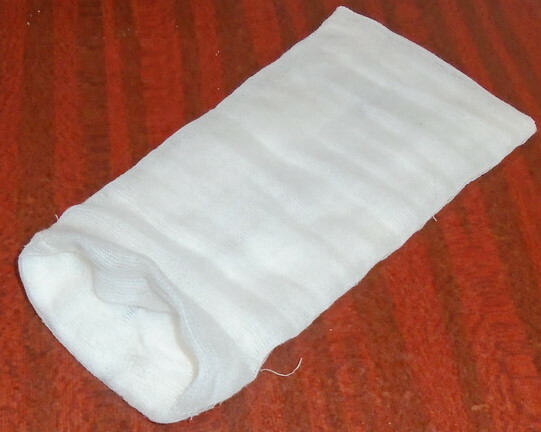
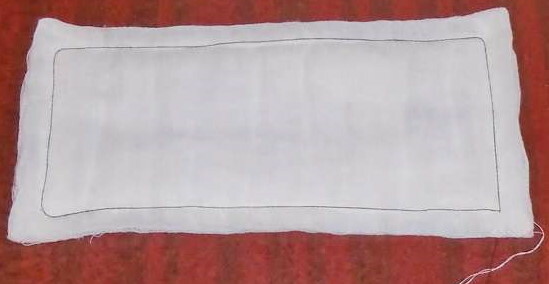
- Cut off 25 cm from the elastic tape. If the ribbon stretches a lot, then you can make the tie even shorter.
- Burn the edges of the tape with a lighter so that they do not bloom.
- Attach both ends of the tie to the sides of the tie and stitch.
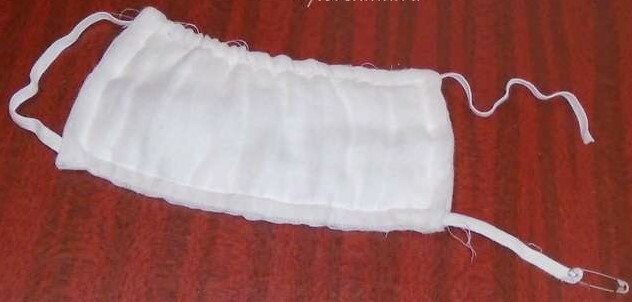
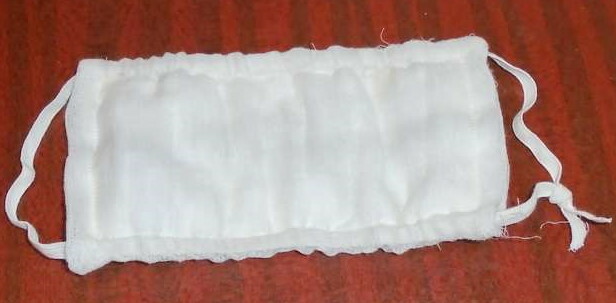
This headband is worn on top of the head. The tape is located at the back of the head.
Sewing instructions for a headband with 2 elastic loops:
- Cut out a rectangle 25x35 cm from gauze.
- Spread cheesecloth on the table.
- Fold it along the narrow edges, forming 4 folds of the same width. The fabric should be folded like an accordion.
- Fasten the folds by ironing them.
- Sew the edges of the bandage to prevent the folds from straightening.
- Cut 2 pieces of 30 cm in length from a thin elastic tape.
- Fold up the top and bottom edges of the bandage, hem in such a way that drawstrings are formed.
- Pull 1 strap through the top drawstring and the other through the bottom. For convenience, you can use a pin.
- Connect the upper and lower ends of the elastic bands by tying knots.
- Unfold the bandage face down.
- Fluff cotton wool, form a flat square.
- Apply cotton wool to the gauze.
- Cut a rectangle 25x30 cm from gauze.
- Fold it in half.
- Place the blank on top of the cotton wool. Stitch on all sides.
Putting on a bandage, elastic loops are fixed behind the ears. If they turn out to be long, then you can cross each loop in front of the ear. You can remove the length by cutting the loops, and tying new knots.
What is the treatment of cotton-gauze dressings
There are 3 ways to treat reusable cotton-gauze dressings:
- ferry;
- soaking in boiling water with soapy water;
- soaking in a soda solution.
Steam is used to process products that have been previously washed and dried. The bandage needs to be straightened, turn on the steam iron, setting the regulator to the maximum value and after heating the device, iron the product for 10 minutes.
Before washing, you can treat the dressing by leaving it in boiling water for 20 minutes. A few tablespoons of liquid antibacterial soap should be added to the water. Then the bandage is squeezed out and rinsed in warm water with 5% citric acid solution. After wringing, the dressing should be washed.
Soda solution is used to treat clean dressings that will be used to protect the respiratory tract from ammonia or chlorine fumes. For 1 liter of water, add 2 tsp. l. soda. Stir to dissolve the soda. Soak the bandage for 2-3 minutes. You need to put the product on your face immediately after spinning.
How to wear correctly
Rules for wearing a cotton-gauze bandage:
- Wear a bandage in crowded places.

- Do not use the "mask" on the street where there are no people. When wearing the bandage for a long time, microbes begin to multiply on it, which have got on the inside of the product from the human body. There is a risk of developing infections of the mucous membranes.
- Before taking a clean bandage, you need to wash your hands or treat with an antiseptic.
- The bandage should fit snugly against the skin of the face. There should be no gaps on the sides and on the top.
- Dressings need to be changed every 2 hours. In high humidity indoors, it is recommended to change the dressings more often, once every 1 hour. Moisture encourages bacteria to multiply.
- When removing the bandage, do not touch the airway protection cloth with your hands. You need to take the product by the ties. While holding the bandage, you need to put it in a bag and tie a knot tightly. Then put the bag in the bag and store the bandage until washed. You cannot put on the product again. Hands and face should be washed with soap. Then put on a new bandage.
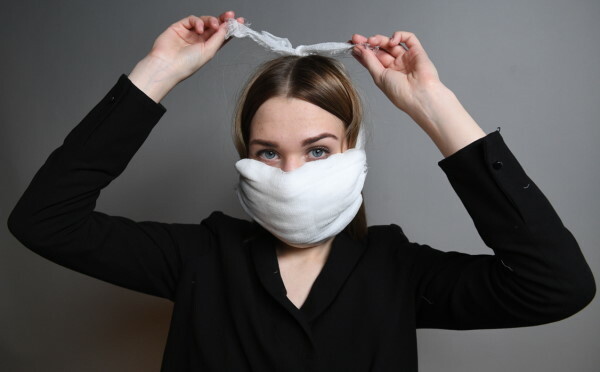
Disposable dressings must be folded into a bag, tied and discarded in trash cans. Do not throw items on the street. Firstly, the environment becomes polluted, and secondly, bacteria on the bandage continue to multiply and can enter the body of another person by airborne droplets. Wearing a "mask" in this case makes no sense, so they must be disposed of according to the rules.
Can the bandage be washed?
Homemade dressings are washable.
Washing rules:
- Washing requires soap that is not used for hand washing or other laundry. It is advisable to purchase a household one.
- You need to wash the dressings in hot water (about 40 degrees), by hand. The cotton filter will crumple in the washing machine. It will be difficult to straighten it.
- You can not wash "masks" with other things. The water after washing also cannot be used to wash any items.
- After washing and drying, the dressing must be ironed with a steam iron.
Before the first use, the dressings must be washed according to the rules, even if they were made from sterile materials. Washing will help get rid of small dust particles from the surface of the gauze or bandage that can enter the respiratory tract.
Common mistakes when using cotton and gauze dressings
What mistakes should not be made when wearing a cotton-gauze bandage:
- Wear a bandage that only covers your mouth. The product may cause slight discomfort, especially in the heat of summer. People, trying to make breathing easier, pull off the chin bandages. Thus, when coughing and sneezing, droplets remain on the surface of the product, but the inhaled air is still not “filtered”. You can get infected not only when a sick person sneezes and coughs nearby. Microbes spread in the air even during normal breathing. Therefore, the nose and mouth must be protected.
- Putting on or changing the bandage with dirty hands. When entering rooms where there may be a large crowd of people, as well as when leaving, many put on and take off the mask without treating their hands with an antiseptic. Before putting on the product, people grasp the handrails in vehicles, touch the door handles, ATM buttons and other objects on which dangerous bacteria can be found. Then the bandages are touched with dirty hands. Microbes settle on the "mask" and can enter the respiratory tract.
- Wear 1 bandage for more than 3 hours. The product gradually becomes dirty. The humid environment that occurs as a result of breathing is a favorable environment for bacteria to thrive. Need to change the bandage on time.
- Dispose of dressings incorrectly. Used disposable dressings, thrown out without a bag in the wrong place, are a source of spread of the disease.
- Putting on and taking off the product incorrectly. Do not touch the canvas covering your face with your hands. It is necessary to take off and put on the "mask", holding it by the strings. Hands should be washed or hand sanitized before putting on and taking off. An example of mask misuse: a person puts on a bandage at home with clean hands, goes outside, visits public places, and touches contaminated objects with his hands. Removes mask with dirty hands, touching nose or lips. The infection gets inside the person. The same mistake can be made by removing the "mask" with clean hands, grasping its central part. Microbes get on the skin of the hands, and then on the face.
You can make a bandage of cotton wool and gauze with your own hands in a few minutes. The main thing is to choose high-quality materials for the manufacture, and then wear and process it, observing all the rules.
Video about cotton-gauze bandage
How to make a cotton-gauze bandage:

